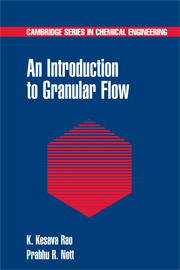Book contents
- Frontmatter
- Contents
- Preface
- Notation
- 1 Introduction
- 2 Theory for Slow Plane Flow
- 3 Flow through Hoppers
- 4 Flow through Wedge-Shaped Bunkers
- 5 Theory for Slow Three-Dimensional Flow
- 6 Flow through Axisymmetric Hoppers and Bunkers
- 7 Theory for Rapid Flow of Smooth, Inelastic Particles
- 8 Analysis of Rapid Flow in Simple Geometries
- 9 Theory for Rapid Flow of Rough, Inelastic Particles
- 10 Hybrid Theories
- Appendix A Operations with Vectors and Tensors
- Appendix B The Stress Tensor
- Appendix C Hyperbolic Partial Differential Equations of First Order
- Appendix D Jump Balances
- Appendix E Discontinuous Solutions of Hyperbolic Equations
- Appendix F Proof of the Coaxiality Condition
- Appendix G Material Frame Indifference
- Appendix H The Evaluation of Some Integrals
- Appendix I A Brief Introduction to Linear Stability Theory
- Appendix J Pseudo Scalars, Vectors, and Tensors
- Appendix K Answers to Selected Problems
- References
- Index
8 - Analysis of Rapid Flow in Simple Geometries
Published online by Cambridge University Press: 19 November 2009
- Frontmatter
- Contents
- Preface
- Notation
- 1 Introduction
- 2 Theory for Slow Plane Flow
- 3 Flow through Hoppers
- 4 Flow through Wedge-Shaped Bunkers
- 5 Theory for Slow Three-Dimensional Flow
- 6 Flow through Axisymmetric Hoppers and Bunkers
- 7 Theory for Rapid Flow of Smooth, Inelastic Particles
- 8 Analysis of Rapid Flow in Simple Geometries
- 9 Theory for Rapid Flow of Rough, Inelastic Particles
- 10 Hybrid Theories
- Appendix A Operations with Vectors and Tensors
- Appendix B The Stress Tensor
- Appendix C Hyperbolic Partial Differential Equations of First Order
- Appendix D Jump Balances
- Appendix E Discontinuous Solutions of Hyperbolic Equations
- Appendix F Proof of the Coaxiality Condition
- Appendix G Material Frame Indifference
- Appendix H The Evaluation of Some Integrals
- Appendix I A Brief Introduction to Linear Stability Theory
- Appendix J Pseudo Scalars, Vectors, and Tensors
- Appendix K Answers to Selected Problems
- References
- Index
Summary
In this chapter, we apply the hydrodynamic equations derived in Chapter 7 to some simple flow problems, and compare the results with experimental data, where available. In each of the problems, we shall first employ the heuristic description of Haff (1983) (see §7.2), followed by the kinetic theory model that was described in Chapter 7. The simplifications made in the heuristic high-density theory allow relatively easy solution of the equations of motion, and give physical insight into the behavior. The results of the kinetic theory, when compared with those of the heuristic high-density theory, gives us an understanding of the effects of the compressibility of the granular medium. We also see how the results of the high-density theory appear as a certain limit of the kinetic theory.
All the problems that we consider, indeed all problems of practical interest, require the specification of boundary conditions at solid walls. In some cases, such as flow in inclined chutes, we also require boundary conditions at a free surface, i.e., the interface between the granular medium and the atmosphere. For the flow of fluids, the no-slip boundary condition is usually imposed at solidwalls, thereby specifying the velocity of the fluid at thewalls. The temperature of the fluid at the walls is set by specifying the temperature of the walls, or by specifying the flux of energy at the walls. In addition, the pressure at some of the boundaries must be specified. Boundary conditions for granular materials are significantly different: they usually display considerable slip at solid boundaries, and the grain temperature clearly has little to do with the thermodynamic temperature of the walls.
- Type
- Chapter
- Information
- An Introduction to Granular Flow , pp. 331 - 373Publisher: Cambridge University PressPrint publication year: 2008



